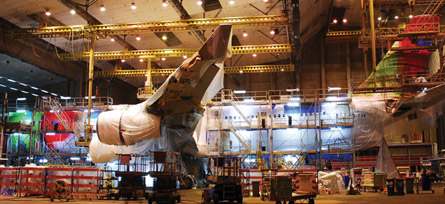TAP Maintenance & Engineering plans to expand its engine shop in Lisbon and join forces with other airlines and maintenance, repair and overhaul (MRO) providers to support the Airbus A350 independently from the original equipment manufacturers (OEMs).
Servicing engines will be the main growth area for TAP M&E over the next years. The company specialises in the CFM International CFM56 family and has full overhaul capability from the CFM56-3 series up to the -7B model. Stemming from the days when TAP operated the A310, the MRO provider also supports General Electric CF6-80C2 powerplants and is now evaluating whether to expand this capability to the -80E1 variant for the A330. This is to be decided in the next few months, says Jorge Sobral, TAP's board member responsible for the M&E unit.
 |
|---|
| © TAP TAP outsources some maintenance work to Brazil to free up capacity in Lisbon |
The overhaul shop has a maximum annual capacity of 120 engines. About 70% of the serviced powerplants are from third-party customers, with the rest coming from the TAP fleet. Even though the facility has not been filled in the past few years, the maintenance company plans to extend capacity by 25% to 150 overhauls in future, through increasing efficiency and expanding the plant.
However, Sobral cautions that building will not begin within the next two years. "We are doing it in phases [because] we have to be careful not to stop working in the current workshop," he says.
TAP is looking at a follow-up model for the CFM56 overhaul line. CFM's successor Leap model would be a "logical step", says Carlos Ruivo, marketing and sales vice-president at TAP M&E. But he says the company has also studied the Pratt & Whitney PW1000G and built contacts with the US manufacturer, and that the geared turbofan is a serious contender for future engagement. A decision will be made in around six months.
EXTERNAL CUSTOMERS
In the airframe MRO business, the third-party work ratio is roughly reversed. TAP fleet provides around 60% of work, the remainder coming from external customers. This is unlikely to change, even after the acquisition of the former Varig's technical arm, VEM, in Rio de Janeiro and Porto Alegre, Brazil, in 2005.
"Airframe maintenance never was a lucrative business," says Sobral. TAP's own fleet growth and increasing aircraft utilisation has largely occupied the MRO division over the past 10 years. Extensive checks on the carrier's long-haul fleet have been transferred to Brazil not just because of lower labour rates but also to free up capacity in Lisbon, as there is no space for expansion there. Sobral says that even though airframe MRO is not a significant business, hangar bays are needed because the work is a central part of flight hour-based, full-service packages for third-party customers.
COST ADVANTAGES
Airframe maintenance is set to increase at the Brazilian sites as a result of Latin America's airline growth and cost advantages for carriers in North America. The long-term trend, however, is that the labour-intensive airframe maintenance work will decrease with the introduction of new aircraft.
A challenge will be to support the ordered fleet of 12 A350s. While manufacturers have tightened their grip of the MRO market and restrict free access to maintenance documentation, TAP M&E has decided not to become part of an OEM network. "We have had that experience in the past, and we didn't like it," says Sobral.
The parent company has instead joined a group of airlines that are planning to pool their resources and split the maintenance work aircraft between them. With their combined fleet order, the airlines hope to have enough leverage against the OEMs to secure access to the required documentation and be able to develop the respective technical capabilities.
The idea follows previous MRO partnerships, such as the former Atlas and KSSU groups among European airlines between the 1970s and 1990s. The crucial difference is, however, that the carriers today do not want to work together just to share the maintenance burden of their own fleets, but to offer their services also to third-party customers.
The group, which has been meeting for some time, mainly comprises European airlines but also includes some North American operators. Among them are a number of airline-affiliated MRO providers who compete with each other on the open market, reports Sobral. "We want to compete. But we want to compete in a decent way, not in a way that the OEMs like to impose."
Source: Flight International



















